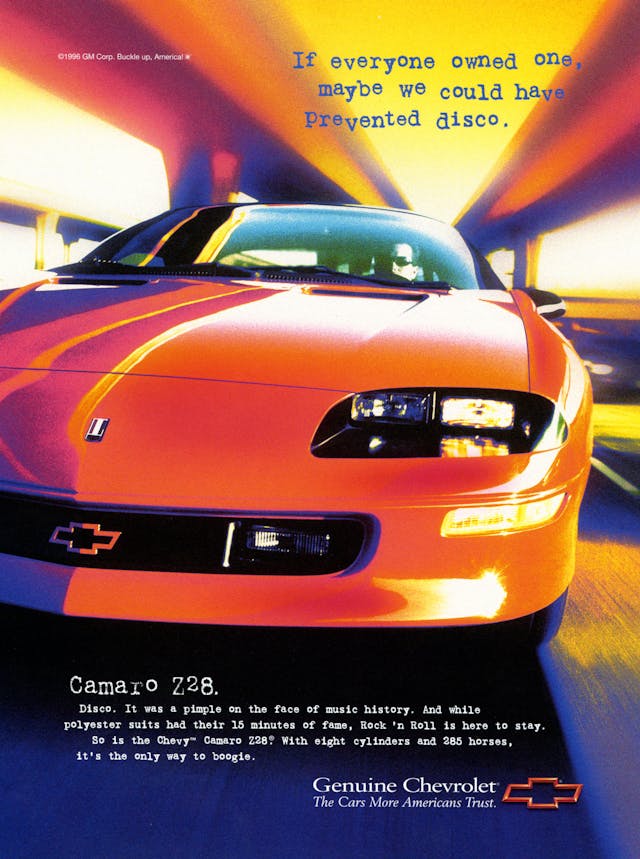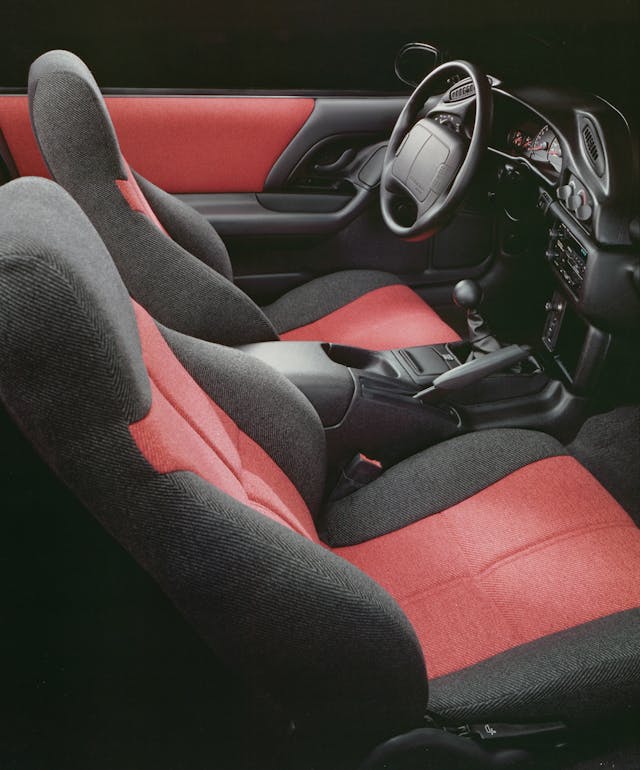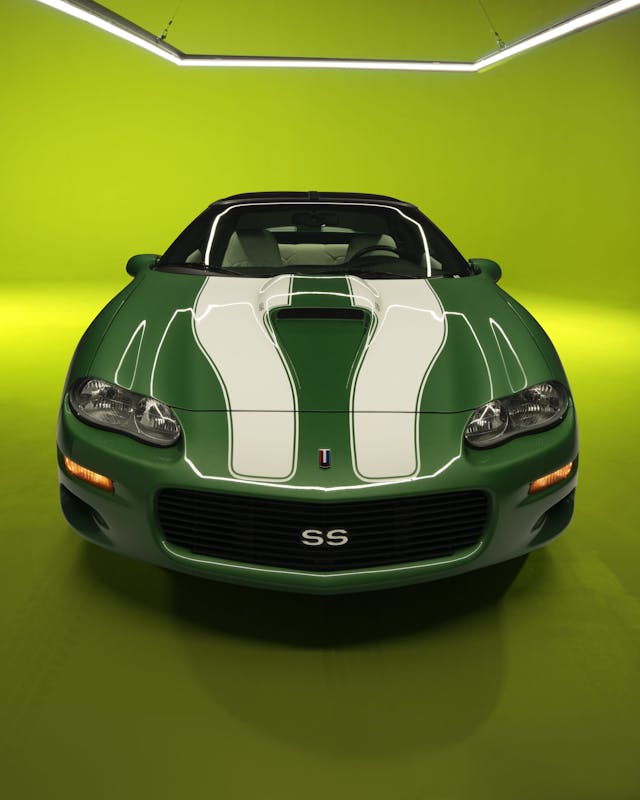Fourth-Gen Camaro (1993–2002): The one that died first
With the Camaro nameplate retiring soon, we’re honoring the beloved two-door with a series of love letters, fun lists, and memories that you can follow here. Many performance cars, especially nowadays, aim for an anodyne version of perfection that only a few can afford. The Camaro is for the rest of us—and it’s always ready to party. Still, we can’t pretend the car we’re about to celebrate over the next week or so is perfect. That in mind, let down your hair and come with us for a deep dive into what, exactly, makes the fourth-gen Camaro so bitchin’.
It’s more or less common knowledge that the Ford Mustang nearly became a front-wheel-drive car in the 1990s, a diversion that ultimately produced the Probe. The Camaro had its own brush with front-drive around the same time, yet the program failed to meet weight, cost, and safety targets. This was pretty much standard operating procedure for General Motors at the time. The company posted its largest-ever loss at $23.5B, a hangover from years of binging on ill-considered technological cure-alls (plastic-bodied Saturns; automated factories where robots wound up spray-painting each other; Lotus).
Despite all that, a new rear-drive Camaro arrived for 1993, and it was a beast. GM had just put the finishing touches on the LT1, the most significant update to the small-block V-8 since its introduction in the 1950s. In the Camaro, it made 275 horsepower, a 30-hp bump compared with the outgoing car and a 40-hp advantage over the contemporary Mustang GT. It sat way back, the block tucked under the cowl of the windshield for better weight distribution. “It’s almost a mid-front-engine car,” said John Heinricy. (Try to remember that if you’re ever changing the rear spark plugs on one.)
It also had a sophisticated double wishbone front suspension, although getting it to production required a King Solomon–like choice: “The guy who was responsible for the financials said, ‘There’s just no way the program can afford to do a new front and an independent rear suspension,’” recalled Heinricy. “I said, ‘Let’s do the front and hopefully in a couple of years we can come in with a program to upgrade the rear.’”
That proved to be wishful thinking. Annual production at the outset was well over six figures but dropped to around 60,000 a year in the late 1990s. Those volumes for a sports car don’t sound particularly bad to modern ears. Yet GM had miscalculated. “We had configured Sainte-Thérèse [a factory in the suburbs of Montreal] to build two shifts of Camaro and Firebird,” remembered Scott Settlemire, who was product manager for the car in the late 1990s. “By ’96, we went down to one shift, and that’s when you lose stupid amounts of money.”
What went wrong? It’s tempting to point to the broader shift in consumer taste, and this was indeed the period when many would-be coupe buyers started finding their way into small SUVs. Yet as always for the Camaro, there is the inconvenient counter-factual of the Mustang, whose sales skewed upward during the decade. “It’s easy for an engineer to say this, but I blame marketing,” said Heinricy. “They just didn’t take the car seriously.”

The styling didn’t help. Baby boomers, in their millions, were entering midlife and beginning to look back, and much of the car industry was pivoting to indulge their nostalgia. Cars like the Mazda Miata and Dodge Viper winked at the past, and Volkswagen’s New Beetle, shown in concept form in 1995, gave it a full-on bear hug. And yet the wedge-like fourth-gen Camaro, largely the work of GM’s Advanced Studio in Warren with influences from young designers based in California, continued to gaze straight ahead. “Chuck Jordan [GM design chief from 1986 to 1992] was always looking at the horizon—creating the next big thing,” said John Cafaro, who led the studios that designed the Camaro and the Corvette.

By the time the Camaro got a mid-cycle update for 1998, rumors abounded that it was on death’s door. The car itself begged to differ. The all-new aluminum LS1 V-8, which had debuted in the C5 Corvette just a year earlier, brought horsepower unseen since the early 1970s. In the Z28, it put out 305 horsepower; SS models, fitted by after-marketer Street Legal Performance with a cold-air intake and freer-breathing exhaust, made 320 horsepower. It has become gospel in Camaro circles that these numbers were conservative. Heinricy denies underrating the cars but notes that little other than tuning software differentiates a Camaro’s LS1 from a Corvette’s. “It was a very simple thing for somebody in the aftermarket to do a calibration that brings that all to life.”
The car persisted and in its final years became profitable again, per Settlemire, thanks to higher take rates on those V-8s. Yet it ultimately met its demise due to banalities of crash standards. “There was a new head-impact standard that came on to the books on September 1, 2002, and in order for us to meet that, we would have had to severely pad the windshield opening,” Settlemire said. “And it’s kind of hard to see out of a windshield of a fourth gen, anyway.”
Just over 40,000 Camaros made it out of the factory that final year, less than a third of the production of the rival Mustang, which was strutting about with a new Bullitt package. The irony was not lost on the car’s internal champions. “Ford saw the Mustang as something really important… they decided to go after it and keep it going,” said Heinricy. “GM just didn’t feel that way about Camaros.”
***
Check out the Hagerty Media homepage so you don’t miss a single story, or better yet, bookmark it. To get our best stories delivered right to your inbox, subscribe to our newsletters.



I’ve really come to appreciate the 4th gens since my son bought one back in April. A black 1999 Z28 T-top with an LS1 and 6-speed. A previous owner installed headers, an SLP exhaust, SLP air box, a clutch for a C4 ZR1 and CV01 black wheels from a C4 ZR1 (16×9.5″ front and 16×11″ rear). Dynoed at 345-hp at the rear wheels.
Does anyone have the real production numbers for 1997 camaro anniversary edition, white with factory orange stripes
The 4th gen was a very under appreciate car.
The story of the 4th could make for a good book. There was so much going on in this era and changes.
The GM 80 FWD AWD came close to happening. But Ford kept the RWD Fox and it let the engineers win at GM.
The styling of the 4th gen was lifted from the 89 Fiero GT per John Schinella. Also the interior used parts of the canceled Fiero.
GM at this time also had been testing a 3rd gen with a C4 rear suspension. I saw the car at Pontiac in the early 90’s.
GM really let the car die as they were going broke and money was needed in programs with more return on the investment.
The present platform would not pass new crash test standards.
To the Credit of many and Scott Settlemire they were able to bring the car back for two more gens.
The 4th Generation F-Body had the negatives of the layout such as the passenger side catalytic converter hump, the solid rear axle, a packaging issue for a true dual exhaust and an engine that was located tight under the cowl.
The positives outweighed it.
The powertrains were reliable and could be modified for more power and torque. A great seating position with easy to function controls. The ride and handling were adequate for the price point. And the looks, especially the Pontiac, had a presence not found on the Corvette or Mustang.
They lived in a time where they were expensive enough to be a primary car but good enough that if you wanted to enjoy them, you would relegate something else to daily driver use.
Now they are appreciating, faster than their peers and they still are a great way to see the country dependably and stand out in a sea of grey and silver SUV’s and pick-ups.
Long live the F-Body.
Hear! Hear!
The biggest letdown on this vehicle was the interior. I always liked them, they had great V8 powertrains. Would have been neat to see a turbo or supercharged 3.8 V6 in one of these cars instead of the plain V6’s this car got.
Truth about the interior. My sons 1999 interior is in decent shape but the quality is definitely lacking. The headliner and visors are the worst part. The headliner is worn and very thin in some areas (fortunately, the T-tops make up the vast majority of the roof). The visors are junk. I’ve had to plastic-weld the console lid a couple times to fix the latch. And the other plastics just feel cheap.
The 4th gen is not what I would call a “timeless classic”, with universal appeal. I don’t foresee the day when GM introduces a “retro” version of this generation, in the same way they did with the 5th gen, which revisited the 1969 Camaro. That said, the 4th gen was a product of its time, and certainly popular in the 90s. Like others, I have come to appreciate the “Rad” styling and true engineering that went into the 4th generation cars. In time, the hero models will climb up in desirability, while the non-V8s and other versions get left behind.
The fourth-gen was one of the worst Camaros. It was the culmination of how Camaro had lost its way for a long time. Chevy needed to temporarily kill off the Camaro after this in order to spark some desire in the hearts of the engineers and bean counters to make Camaro right again. Sure, Gen5 has it’s issues, but it fixed a ton of what was wrong with Gen4.
Maybe – but the 5th (and 6th) blundered in one way vs. the 4th: the visibility is much worse in the newer Camaros than in the 4th – despite how low-slung the 4th-gen is.
I had a 95 convertible, and thought it was a great looking car in addition to being one of the best driving cars I’ve ever owned. I was sad to see it go — even though it’s replacement was a C5 Corvette convert.
I still greatly enjoy driving my 2002 Z28 convertible, bought new in 2008 (yes, 2008). Quick, great-handling, and (somewhat firm ride aside) relatively comfortable, even for my 60-something body. And, like the C4 Corvette, the Camaro’s dart-like form is so much sleeker than the ones that followed.
Not sure why we would have wanted to prevent disco, but since the Camaro’s cousin, the Trans Am, was such a big part of the disco era and scene, I am not sure that more Camaros would really have helped!
I had a beautiful, bright red, 1998 Camaro convertible. I loved the car and had a blast driving it. I had broken my back in a car wreck several years before getting the Camero, and the low seating position eventually began giving me back ache if I was in the car any length of time. I ended up buying a 1965 Mustang convertible and sold the Camaro to finance some engine modifications on its A code 289. I still have the Mustang, and drive it regularly, but I do miss the Camaro. It looked fast even when it was sitting still!
I bought a 94. Really liked it. But in hind sight I wished I kept my 88
Denied underrating but my 310hp 2001 Z28 6 speed manual put down 324rwhp and 341 rwtrq with zero mods. 😂
I’m not sure why the Boomers were referenced here as a market for this 4th-gen F-body. By 1993 they were well established financially in their 40s and beyond and far out of this market for performance (Corvettes, Porsches, etc.). No, this car, as every F-body generation before it, was targeted at the younger demographics for an affordable performance car. In this case, it was Gen-X who in the 1980s were too young to afford a new 3rd-gen (although I was fortunate enough to have owned two of them between high school and college).
These LT1 powered new 4th-gens sold like hotcakes, and I broke my own rule of ever buying a new generation car, by ordering a new 1993 Firebird Formula 6-speed. I had faith in it because the LT1 had a year of proof in the 1992 Corvette. It was my first new car purchase during my first corporate job out of college with a decent paycheck. There were so many of us just in my region of the Southeast at the time that we formed an F-body club in the mid-1990s after the internet took off. There were hundreds of us young professionals in our 20s just between FL, GA, SC, NC, TN, and AL alone!
The LS6 was probably 350-360 hp at the crank, but not nearly as fast as the 6 liter GTO…